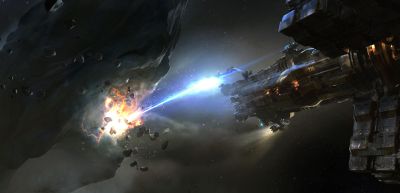 | |||||||||||||||||||||||||||||||||||||||
| 系列 | Design | ||||||||||||||||||||||||||||||||||||||
|---|---|---|---|---|---|---|---|---|---|---|---|---|---|---|---|---|---|---|---|---|---|---|---|---|---|---|---|---|---|---|---|---|---|---|---|---|---|---|---|
| 类型 | Transmission | ||||||||||||||||||||||||||||||||||||||
| ID | 14522 | ||||||||||||||||||||||||||||||||||||||
| 发布日期 | 2015-02-21 | ||||||||||||||||||||||||||||||||||||||
| 来源 | Star Citizen Careers: Mining | ||||||||||||||||||||||||||||||||||||||
| 系列文章 | |||||||||||||||||||||||||||||||||||||||
| |||||||||||||||||||||||||||||||||||||||
Sic itur ad astra.
by Tony Zurovec, Director, 持续性宇宙
星际公民’s ultimate objective is to present players with a vast, incredibly detailed universe where everyone can forge their own unique path through the stars. To that end, we’re going to great lengths to ensure that – whatever your interest – there’s an enormous amount of things for you to do and obstacles to overcome.
Star Citizen will support a diverse set of occupations, each with its own unique set of challenges and rewards. However, there is no artificial concept of a character having to select a specific profession or character progression based upon gradually incrementing numeric attributes. The only thing that dictates your success or failure at a given endeavor are the actual capabilities of you and your companions and the equipment you bring to bear.
The first of several occupations we’ll be aiming to detail over the ensuing months is mining. In many ways, it is representative of the basic design goals for all of the occupations within Star Citizen.
Mining presents players with a variety of challenges requiring skill and intelligence, whereas mindless repetition of a task and idle drudgery are explicitly avoided. There are no aspects of mining that allow a player to simply press a button and wait without concern for a result, or that require players to perform an action repeatedly without some element of thought and/or dexterity coming into play.
Ample amounts of dangerous situations are afforded, despite the fact that combat isn’t inherent in any fundamental aspect of the effort. The most valuable materials will often reside deep within a dense field, the result of less experienced pilots being unable to extricate them without suffering serious damage to their ship. Compressed pockets of gas, volatile materials that can explode in the presence of excessive energy (which is required in some capacity in order to liberate the ore from its parent asteroid), and elements that can explode when subjected to seismic vibrations as caused by repeated fragmentation operations all present their own unique types of jeopardy. While most miners will seek to actively avoid armed conflict, the reality is that any ship carrying a cargo of valuable ore will present a tempting target to less scrupulous types, rewarding those players that formulate contingency plans in advance, whether that be the hiring of an NPC crew member extremely talented with a defense turret, or investing a portion of the expected profits into hiring an armed escort or two.
Finally, multiple roles of substance are presented, each of which is referred to as a specialist. Every role can occupy the full attention of a player and present sufficient challenge to keep them engaged, or assigned to an NPC whose skills are commensurate with their monthly cost.
The Trade and Development Division
A trip to the local Trade and Development Division – the TDD – is often the first step on a prospective miner’s list. The TDD serves as a marketplace for the various commodities and other products available at a given location, and as such gives a good sense of what’s in demand and therefore which materials warrant the most attention in terms of obtaining the most attractive profit margins.
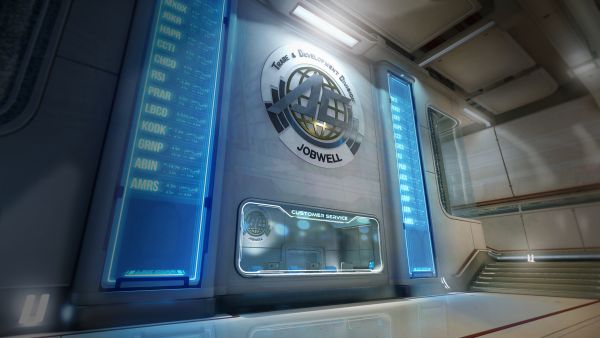
Freelance mining versus working as an agent
When deciding upon a course of action, every miner has two basic options – working freelance or acting as an agent in the employ of another entity. Freelance miners elect which materials they want to procure and, after retrieval, set out to find the optimal trading port at which to unload them. While potentially the most lucrative, this approach exposes miners to the vagaries of the market, and if demand wanes during the acquisition of the materials the price eventually obtained might be insufficient to have warranted the effort and expense endured, especially if significant expenses were suffered in the form of costly NPC crew members having been utilized, fuel having been expended, or damage to the ship having occurred.
Miners working under contract for another entity remove most of the risk from their ledger, but in so doing often have to give up a significant portion of their cargo’s value in exchange for the benefit locking in a fixed price. Further, they risk a hit to their reputation if they are unable to procure the promised materials within the specified timeframe. The information gleaned from the TDD is of significant benefit in ascertaining whether the discount being offered is warranted by the security of a guaranteed contract.
Finding a suitable asteroid field
Once a basic mining path – freelance or contract – has been decided upon a player must put some thought into how they wish to locate the sought-after materials. Asteroid fields containing ore of varying purity levels litter most star systems, but prior to a miner engaging their quantum drive and making haste to begin extracting value from the environment, they must gain knowledge of those fields.
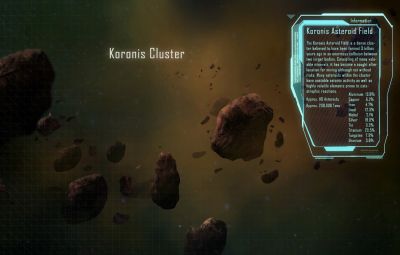
To this end, every solar system contains a variety of information considered public knowledge, including the location of major asteroid fields. The entry-level miner often begins their career via heading towards such well-known sites, but as would be expected the most valuable materials in such fields have typically long since been extracted. The remaining ore of value is often spread so thinly throughout a vast field that its retrieval requires more time and effort than more advanced miners are willing to endure. Valuable new fields are occasionally located and made known to the public, often resulting in a dramatic increase in mining activity… and soon thereafter a drop in prices on those materials contained in ample quantity within the field as players rush to exploit the freely available resource.
Alternatively, miners may elect to employ the services of an information broker who, for a price, will offer the locations of a variety of smaller fields unknown to the public. While more reputable brokers will truthfully report the type and quantity of materials to be found within a particular field, there are some who have been known to exaggerate the assets contained within a field whose location they are seeking to sell.
The last and most time-consuming option – but also potentially the most lucrative for those able to master another discipline – in terms of finding an asteroid field to exploit is to simply act as a Pioneer and find your own. The Pioneer occupation specializes in the utilization of long range scanners and telemetry probes to scan huge swaths of space and find anomalies that warrant further investigation, with the end result that some turn out to be small fields of asteroids, occasionally with an attractive mix of valuable materials embedded within them. When acting in such capacity on your own – and not as an agent in the employ of another entity – the discovery of something remains known only to you. In such cases, you may elect to sell such information to a broker – with the price being dictated by the type and quantity of materials within the field, as well as the current market rates – who would then offer that information to others.
This last option – finding your own asteroid fields – has one variation that we expect to see widely utilized. Organizations may automatically share private discoveries amongst themselves, such that finding an asteroid field – or a derelict spaceship that could be salvaged, or astronomical phenomena that might be studied by an aspiring scientist, and other such things – would result in its location immediately becoming known to others within that organization but remaining hidden from the rest of the public. Thus, we expect that many organizations will wind up having a very vertically oriented and complementary set of occupations represented within its ranks, such that it can effectively cut out the middle man in many wealth-generating transactions and retain more value for itself and its constituents.
The Orion
The extraction of ore from huge asteroids requires a very specialized type of ship. The first such ship to be offered to the community – via a concept sale starting today – is the Roberts Space Industries’ 猎户座. It allows individuals to directly compete with the major corporations that previously controlled the space-based mining industry. It’s a huge ship, measuring 170 meters in length, and containing a variety of storage containers capable of holding 16,288 standard cargo units of ore.
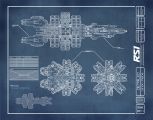 | 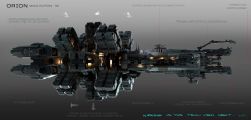 | 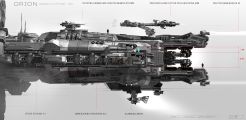 | 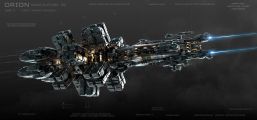 |
<embedvideo service="vimeo">https://vimeo.com/120215201}}
Mining specialists
The mining occupation supports a variety of dedicated specialists, each of which has a critical role to play in the effort. As previously noted, one of the basic objectives in the design of the various occupations is breaking down large, complicated endeavors into a number of smaller jobs, each of which can test a dedicated player’s mettle in unique and interesting ways. This encourages but does not force players to act in concert with one another to accomplish larger tasks, as you’ll always have the option of simply doing it all yourself – however inefficient that might be – or, more likely, simply hiring NPC crew members to work alongside you. There’s a lot of thought and effort going into the hiring, evolution, simulation of motivations, and evaluation of such NPC crew members, but that’s a topic best left for another discussion.
Pilot
The pilot, of course, navigates the ship. While this sounds straightforward, in practice it is often challenging as impacting an asteroid can seriously damage a player’s ship, and the asteroids with the most attractive resource compositions are often deep within a concentrated field. Pilots make the final call as to which individual asteroid warrants the most immediate attention, often choosing from an array of possible targets identified via the scanning process. They also determine whether to remain in a fixed position around an asteroid throughout the excavation process or to adopt a more active role, gradually rotating around a selected asteroid and thus giving the beam operator a better opportunity to find and extract valuable pockets of buried ore. Many asteroids are filled with dangerous materials that, under the right conditions, can blow the asteroid to pieces, increasing the value of a good pilot that can quickly navigate a ship to a safe distance even when the warning time is minimal.
Scan operator
The scan operator is responsible for injecting remote material analysis packages (RMAPs) into nearby asteroids that, upon success, immediately begin sending telemetry data back to the pilot and scan operator informing them as to the asteroid’s precise material composition. Depending upon the ship and its associated hardware, anywhere from several dozen to hundreds of RMAP-equipped manually guided missiles may reside upon a mining vessel.
Upon selection of an asteroid, the center of mass is automatically calculated and the scan operator begins the process of gradually scanning for a suitable RMAP insertion point. This is a multi-faceted process involving a search for a section of surface geometry oriented such that its perpendicular traverses the center of mass or somewhere close to it. The operator receives feedback on the angular difference, but it’s ultimately their call as to whether a given site is good enough or not.
Once an insertion site has been selected, the location and optimal injection orientation are displayed, and the scan operator may launch an RMAP-equipped missile. The missile’s thrust and guidance system are manually controlled, with the objective being to impact the asteroid at the precise point and with the exact orientation dictated via the previous step. The distance from the computer-specified injection position, deviation from the optimal angle, base material of the asteroid, and final impact velocity ultimately determine whether an injection is successful or not.
One interesting aspect of this particular effort is that the confidence of the scan operator plays a significant role. The more optimal the initial insertion point selected – which typically takes more time to achieve – the larger the error can be in the subsequent missile guidance stage and still achieve a successful insertion. More skilled operators, therefore, will often be willing to accept even a mediocre insertion site so that they may quickly proceed to the next stage, confident in their ability to hit the precise location at the specified speed and angle such that they’ll still be able to achieve success.
Beam operator
The beam operator is typically the second-in-command of a mining expedition. They are responsible for wielding the multi-megawatt mining beam generators affixed to one or more robotic arms near the front of the ship that fracture asteroids into digestible chunks. The beam operator has direct control over the output wattage, and is thus able to precisely control how much energy to dispense into a given area of an asteroid. This is critically important, as the injection of surplus energy into a volatile material can cause an explosive chain reaction to occur, with the total destructive force ultimately determined by the type and amount of reacting material. The beam equivalent of a sledgehammer, therefore, can be used to quickly excavate large quantities of inert materials, but a lower-wattage scalpel will be necessary when attempting to safely extricate those that may react violently in the presence of sufficient energy.
The Exothermic Reaction Detector is a status display on the beam operator’s control panel that detects the production of excess energy indicative of the fact that the mining beam is causing a chain reaction in some portion of the materials in close proximity to the beam. This information is presented to the operator in the form of a vertical bar graph plotted over time showing the probability per second of such a reaction growing out of control and consuming – often in a powerful burst of energy that can send huge, dangerous shards of the asteroid flying towards the player’s ship – all of the material in the nearby area.
Exothermic Reaction Detector
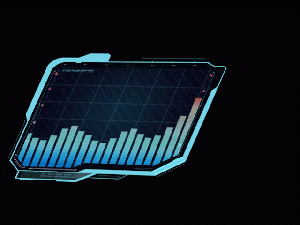
Every minable material has its own unique set of parameters dictating how much energy a given quantity can absorb, how quickly it can dissipate energy, how easily it can transfer excess energy to surrounding materials, its probability of fragmentation as energy levels reach critical levels, and numerous other things.
The average size of the fragments carved from an asteroid as the result of a mining beam being utilized, then, depend upon the amount of wattage the beam is injecting into the body, as well as the type of materials into which the energy is being directed.
As fragments are torn asunder from the parent body, they generate seismic tremors that resonate throughout the asteroid and only gradually dissipate. Some volatile materials are sensitive to such vibrations, and as such minimizing the magnitude of any such tremors is often of considerable concern. This is complicated, however, by the fact that such tremors are modeled independently of one another, with the sum total displacement caused by the superposition of the waves constantly being applied against the various materials within the asteroid. Thus, even a series of small tremors can present a serious threat depending upon how the waves interfere with one another.
Laser Seismometer
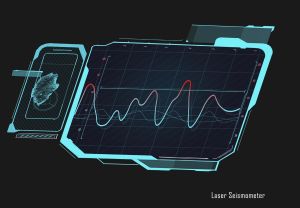
The Laser Seismometer shows each individual tremor within an asteroid, as well as the superposition of the various waves. It also shows the vibrational thresholds for any seismically sensitive materials contained within the asteroid, assuming that an RMAP has been successfully injected. Explosions that occur as the result of a seismic event are often considerably more dangerous than chain reactions that consume a quantity of material in a localized area because they will cause all such material within the entire asteroid to detonate, with the end result often being the complete destruction of the asteroid, and a pronounced danger to any mining ship unfortunate enough to be in close proximity at the time. Fortunately, such events are often telegraphed in advance via seismic activity growing progressively more erratic and tiny pockets of material prematurely detonating and causing the ejection of small sections of the asteroid into space.
Highly compressed pockets of gas buried within an asteroid present another distinct danger to a mining operation. Exposure of even a small portion of a gas pocket to the vacuum of space results in an immediate explosive decompression that can splinter nearby sections of the asteroid, send astronauts hurtling through space, and generate considerable seismic turbulence.
Analytical Materials Processor
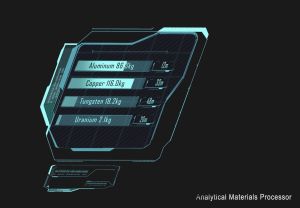
The mining beam is equipped with a high-energy scanning probe called the Analytical Materials Processor that provides constant feedback as to what type of materials lie beneath the surface – within range of the probe – in the specified direction. Each material identified is presented on a horizontal bar graph replete with information regarding the depth at which it can be found and the approximate quantity.
Cargo operator
The cargo operator utilizes a console on the bridge of the ship that allows them to monitor a camera mounted within the forward-facing input port. From that vantage point the cargo operator can view the impact area of the mining beam, as well as the various asteroid fragments that are broken apart from the parent body and ejected out into space. The input port contains a powerful crusher that quickly reduces any incoming asteroid fragments to rubble and stores them in attached cargo modules for transport or, on ships with an integrated refinery, subsequent processing into their purified elemental forms.
The cargo operator directs a targeting cursor towards fragments of interest, with an integrated Fragment Scanner – similar to the Analytical Materials Processor utilized by the beam operator – providing immediate feedback in regard to the fragment’s precise composition. In this manner, the operator is able to get a quick sense as to the relative value of the fragment, and whether it is worth attempting to guide it into the input port, or whether it contains so little of value that it’s best avoided so as to preserve precious cargo space or time-consuming refining effort. The Fragment Scanner also displays the object’s mass, trajectory, and velocity.
The cargo operator controls attractor and repulsor beam generators typically mounted just within or outside the input port, and the magnitude of the force generated by each can be precisely controlled so as to allow for intricate modification and control of a fragment’s trajectory. The cargo operator’s display allows for a variable magnification zoom, which is necessary since attractive and repulsive forces are applied at the precise location denoted by the target cursor. Application of force to a fragment’s extremity, then, will typically result in generating a rotation on the object rather than any significant change in its direction. Thus, considerable skill – including the ability to quickly estimate an object’s approximate center of mass – is required in order to efficiently apply forces and guide fragments along the desired path.
Refinery operator
The position of refinery operator only exists on mining ships that contain an integrated refinery. Refineries allow raw ore to be gradually converted into their purified component forms, with the undesirable elements being ejected back out into space in the form of dust. Purified materials consume a small fraction of the storage space of their unrefined counterparts, which is of particular concern when dealing with low quality asteroid fields that possess valuable elements only in a highly diffused form, or when attempting to minimize the number of return trips back to a trading or storage facility. The refinery operator controls the routing of ore to a variety of specialized processing units, each of which has a different role to play in the separation of one material from another. Operator errors in the refinement process can cause sensitive equipment to fail, stalling the conversion process and costing valuable time until the affected item is replaced, typically with a surplus part stored in the ship’s inventory.
All of the aforementioned specialist positions may be helmed by either a player or an NPC, with more experienced NPCs performing their duties in superior fashion, but usually at the expense of demanding a higher monthly salary.
Selling Your Cargo
The final step in the mining process is converting your meticulously collected ore or refined materials into payment for your efforts.
If you accepted a job, you’ll want to return to the agent that hired you and complete the transaction, resulting in your account being credited for the promised amount and a bump in your reputation for successfully completing the task. The agent will only purchase the specific type and quantity of materials that you promised to deliver, though, so you’ll likely want to head to the local TDD to convert any surplus materials into credits.
For players that elected to operate as freelance miners, the path is often a bit less clear. Different TDDs at different landing zones may offer dramatically different prices, so you’ll often want to do a bit of due diligence and ensure that you’re not leaving any money on the table by quickly accepting whatever’s being offered at the closest landing zone. The really significant scores, though, are often made by extracting a common material of limited value in one star system, and then transporting it to another where it’s in shortly supply and the prices are much higher. It’s your choice as to whether you want to operate exclusively as a miner, or do double duty as a transport freighter by lugging your own valuable cargo across the galaxy, and whether the risks you’ll face in that endeavor – as you get ever closer to an area where your material is highly valued, you’ll become a much more tempting target – are justified by the richer potential payday.
One last option that some miners might wish to undertake is related to speculation. If you’re inclined to gamble, some landing zones will offer storage facilities that you can purchase on a monthly basis. Rather than selling your cargo immediately, you might wish to hold on to it, with the hope or expectation that – perhaps as a result of actions you’re planning to initiate with the aid of your organization – prices might rise significantly in the near future.
"Ultimately, that’s what Star Citizen is all about – every player making their own unique decisions as to how they want to proceed at every step of the way."



